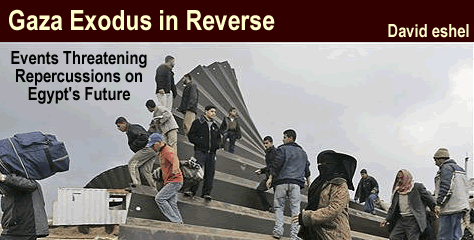View the CBS News Photo Essay on the Gaza – Rafah situation
These are moments of glory for Hamas. It conducted its campaign brilliantly last week, and as it seems, so far, with complete success. At no stage did Israel have sufficient response to counter the initiatives of Hamas: Its excellent intelligence community, normally capable of pinpointing Hamas leaders for targeted killings, failed to alert on the organization’s preparations along Philadelphi border line separating the Gaza strip from Egypt. But in fact, not intelligence gathering, nor experts, just plain common sense was the only thing needed to realize, that breaking the barrier between besieged Palestinian Rafah and free Egyptian Rafah, was only a matter of time.

 It was also an impressive engineering feat. To plan, plant, implement and execute simultaneous explosions, creating a domino effect, toppling such a strongly built infrastructure, required high level professionalism. Analysts doubt that Hamas, alone could not have done this, without professional outside help. Intelligence sources suspect, that Iranian demolition experts arrived in Gaza, mingling with the pilgrims from Hajj in Saudi Arabia three weeks ago, when Egypt allowed them, reluctantly to return, without sufficient security checks.
It was also an impressive engineering feat. To plan, plant, implement and execute simultaneous explosions, creating a domino effect, toppling such a strongly built infrastructure, required high level professionalism. Analysts doubt that Hamas, alone could not have done this, without professional outside help. Intelligence sources suspect, that Iranian demolition experts arrived in Gaza, mingling with the pilgrims from Hajj in Saudi Arabia three weeks ago, when Egypt allowed them, reluctantly to return, without sufficient security checks.
Hamas operatives had been sawing away the foundations of the wall between Egyptian and Palestinian Rafah for a few months, preparing it to blow it up when the time came, a source close to the Popular Resistance Committees (PRC) in Rafah told ‘Haaretz’ newspaper on Wednesday.
Explosions were set at no less than twenty points along the border fence, clear evidence of a campaign that was planned and coordinated well in advance. In destroying the wall separating the Palestinian and Egyptian sides of Rafah, Hamas chalked up another impressive, if not strategic coup. The organization demonstrated once again, that it is a disciplined, determined entity and an opponent that is exponentially more sophisticated than the Palestine Liberation Organization in Ramallah.
But there was much more at stake here. While thousands of Gazans spilled over into Egypt, Hamas military used the confusion to seize Egypt’s strategic deep water port of Rafah on the Gaza Mediterranean coast. In August 2005 the Sharon government granted Egypt naval control over the territorial waters off the Gaza Mediterranean coast up to Ashekelon. Egypt constructed a new 300-meter pier for six 300-ton naval ships on the shore of Rafah, the town which was divided by mutual agreement between Egypt and the Gaza Strip.
Meanwhile a few miles southwest of the border, the Egyptian authorities desperately attempted to set up a more organized line of defense, trying to turn back Palestinians reaching El Arish town, halfway to the Suez Canal zone. But for thousands of Palestinians who flooded through the border breaches, it was the Eastern Mediterranean version of the ancient Bible exodus – only this time in reversed form. It opened a floodgate of people and there was no stopping them, apart from opening fire on the surging crowds, which the Egyptians could not afford.
An interesting development which already seems to emerge is, that on President Mubarak direct orders, the Egyptian border police redeployed to a new line, covering El Arish, Bir Lahfan and Abu Agheila. This step would effectively hand over to the control of Hamas-led Palestinian terrorist organizations a Northern Sinai void of roughly 855 sq, km., almost twice the area of the Hamas-ruled Gaza Strip.
 Implementing the Grand Design
Implementing the Grand Design
It is little known, that in 2004 retired Major-General Giora Eiland, former chief of Israel’s National Security Council, made a similar proposal to then prime minister Ariel Sharon, calling for a regional solution of the Gaza dilemma. His proposal included adding 600 square kilometers to Gaza in northern Sinai, allowing for the construction of an international port and airport, and a city in which millions of Palestinian refugees could live. Eiland “grand design” plan (see map), sought compensating Egypt with 150 square kilometers in the southern Negev and offer a tunnel connecting Egypt’s Central Sinai with Jordan, north of Eilat. Unfortunately nothing came of General Eiland’s plan. Instead Sharon opted for the unilateral disengagement from Gaza in August 2005, which, turned into a strategic disaster-creating Hamastan, with all its painful “trimmings”.
Egypt’s Security at Risk?
Now Egypt is watching with mounting alarm as the crisis in the Gaza Strip threatens to spill over onto its own heartland. This is part of a nightmare which was haunting Cairo’s security services for years, since Hamas became dominant in the Gaza strip, right on Egypt’s doorstep. Now it seems, that the unpredictable Middle Eastern scenario, in which the ever-volatile Israeli-Palestinian conflict, getting dangerously out of hand, has already matured into a real threat. President Hosni Mubarak is facing a painful dilemma: on the one hand he wants to maintain his, well paying US sponsored, relationship with Israel. On the other he must avoid the impression that he is abandoning the Palestinians, including the hated Gazans, which are Egypt’s traditional pain-in-the neck.
Meanwhile, President Mubarak is pulling out the stops to get Israel to ease its restrictions, limiting the number of his security forces in the Sinai Peninsula, according to the 1979 Peace demilitarization agreement, which allowed only a restricted number of police forces deployed at the Rafah border and even the overall troops levels in Sinai.
Egypt’s security services are already on high alert after learning that the 130,000 Palestinians, living in communities around Cairo, Alexandria and the Suez Canal cities, are preparing to help their Gazan brothers steal into Egypt.
Gaza’s links to Egypt go back to 1948, when it annexed the strip – then part of British-ruled Mandatory Palestine – after the war with Israel, with its population swollen by newly-arrived refugees. Israel occupied it for a few months after the 1956 Suez war but Egyptian rule was restored until the next round in 1967.
There are already significant repercussions to the Hamas coup in Rafah. According to rumors spread among Palestinian media reports, early Thursday, Jan. 24, apparently American forces and equipment were to have wihdrawn from the Multinational-force and Observers (MFO) airbase at El Gora northeast of al Arish. However, a former member of MFO has informed us that this report was factually incorrect. Having contacted MFO officials stationed at North Camp El Gorah there were no plans, at this stage to redeploy or withdraw MFO contingents from this location. This message we find most reassuring to stability in this volatile region and wish to apologize for our earlier report, which seems to have been spread by intentional disinformation from involved sources, during the turmoil which aroused Northern Sinai.
But the danger to Israel’s security in now real and imminent from another direction.
Hamas and other terrorist organizations in the Gaza Strip, have already used the newly open border with Egypt, to dispatch numerous terrorists into the Sinai peninsula over the last two days, with the goal of sending them from Sinai into Israel to commit attacks, defense officials said Thursday. Carrying out spectacular attacks has been a long seeked aim, but was effectively thwarted by the sophisticated Gaza fence barrier. Accordingly, the Israel Defense Forces, the police and the Shin-Bet general security service have consequently beefed up their forces and their alert to highest level, along the Israeli-Egyptian border in an effort to thwart infiltrations. But all these efforts must be regarded virtually as ‘mission impossible’, as the desert stretch from Rafah to Eilat is over two hundred kilometers long, and mostly negotiable by 4×4 vehicles or on foot.
Now that Gazans have ‘exploded’ out of their long besieged enclave, it may be up to Israel to seal up the border again, since the Egyptians are showing no signs of doing so. US Secretary Condoleezza Rice and David Welch, her assistant for the Middle East, made a point of warning Mubarak that he must act expeditiously to restore border security, because the entire Washington Palestinian strategy, hinging on Abbas and the Annapolis declarations, hangs in the balance.
Wake-up Call ending “Pax Americana” illusion
But the Americans have no one to blame but their own president, who, through his dangerous “pax Americana” illusion, tried to bring democratization into a region, where this is still regarded as counter productive, if not catastrophic. It started in Iraq and Afghanistan, spilled over to Egypt, Lebanon and culminated with the 2006 Hamas elections, their July 2007 coup and now, finally the “Sinai exodus”. This latest development could well announce the next step – a possible Moslim Brotherhood takeover bid for the post Mubarak era in Egypt. The Egyptian president already hinted his main worry is not the Palestinian issue but concern that his own opposition, led by the Muslim Brotherhood, may adopt Hamas tactics and stir up trouble in his cities. Foreboding signs are already evident: Underlining domestic sensitivities, 460 members of the semi-outlawed Muslim Brotherhood were arrested Friday, while heading for a demonstration outside the Cairo HQ of the Arab League.
High concern is voiced by analysts over Egypt’s Muslim Brotherhood gains in the recent elections. The Egyptian authorities received a shock last fall, when the Muslim Brotherhood, an officially banned, but venerable and tolerated fundamentalist group, won some 20% of parliamentary seats. The Muslim Brotherhood, established in 1928 became outlawed in Egypt since 1954.
The big question will be, whether Mubarak will allow Israel to mount a decisive military foray into northern Sinai and rout Hamas before it can deploy sufficient power, or link-up with terrorist forces, already strongly established in the barren Sinai mountains. For an effective counteraction, time is critical- any hesitation or political haggling can be catastrophic.
Sinai: Safe House for Terrorism
While the Egypt-Israel 1979 Peace Agreement has de-militarized the entire Sinai Peninsula, it also made it into a giant safe house for terrorism. Sinai’s geographical position places the Sinai Peninsula in a highly strategic area, astride of some of the most ancient smuggling routes through unpopulated desert and extremely difficult topography, making excellent hide-outs in mountain caves. Iran and Al Qaeda have focused on Sinai long ago, but increased its clandestine operations base, with growing emphasis, following the US campaign against Taliban in Afghanistan.
These smuggling routes are of highly strategic importance in Middle East conflicts past, present and future. Counter intelligence sources estimate that major routes lead from as far as the Black Sea to the shores of El- Arish in northern Sinai ferrying arms and contraband in both directions. Now with Hamas in control in parts of Northern Sinai, and realizing that Iran is actively supporting the Islamic organization- an utmost dangerous situation can develop, in which the Iranian Revolutionary Guard Corps (IRGC) will finally establish its long sought forward base along the Mediterranean.
Logically there might be a solution to this insoluble dilemma. Israel could agree to redraw the security annex of the 1979 Egypt-Israel agreement and allow Egypt to deploy several divisions into Sinai, deploying sufficient forces to restore its authority in the lawless peninsula. Taking such a step would, however be extremely dangerous for Israel, taking into account that a major change could occur in a post-Mubaraq regime, in which the Moslem Brotherhood will form a new government and make all agreements with Israel null and void. Under such circumstances, Israel would be faced by no less than four potential frontlines: Hezbollah in Lebanon, Syria, the West Bank ( under Hamas), Gaza Hamastan and a hostile Egyptian Army equipped with the latest US military equipment, matching its own arsenal.
Triggering a Spillover Effect?
But there is more at stake on the immediate outlook. There is little doubt that Hamas’s impressive gains will affect many Arab nations in the Middle East and primarily those, with a growing populating living under squalor and deprivation. Foremost of these will be Jordan, which is populated by over sixty percent Palestinians, many of which admirers of Hamas. Should these rise against the Royal Hashemite Kingdom rule, which they already tried in September 1970, this could prove disastrous to Israel and the United States Middle East policy.
On Friday Muslim Brotherhood activists marched in Amman to protest Israel’s closure on Gaza, and call on Hamas to resume suicide bombings. About 8,000 activists from Jordan’s mainstream Muslim Brotherhood took to the streets in support of their ideological brethren, the Palestinian Hamas group. Jordanian officials have been alarmed. They fear it broadens the popularity of the Islamist movement among a majority of poor Jordanians, many of them living in refugee camps and long disenchanted with the US-led Middle East peace process. “Hamas is winning more supporters every day because it represents the conscience of the nation,” Sheikh Hamza Mansour, a leading Islamist deputy said.
There is however one bright element in these, otherwise all bleak developments: Egypt actually helped Israel on Wednesday, to complete the 2005 disengagement from the Gaza Strip. Moreover, it clearly signaled Hamas’ disengagement from the insignificant and powerless, Ramallah leadership. The obvious would be a long term solution under which the Gaza Strip will be aligned with Cairo, while the West Bank- eventually to Jordan. A two-state Palestine, in which a non-territorial connected Gaza and West Bank can be functioning, is really unthinkable, under such abnormal terms. As matters stand this week, it seems logical, that further talks with the ‘impotent’ Abbas-Fayad team, which is not even ruling the West Bank, is a sheer waste of effort for Israel, which should now concentrate to find a viable solution to the new challenges – which are facing its security.
President Bush’s Annapolis Palestine statehood dream seems no more than wishful thinking under the new circumstances. It is high time for the Washington administration, to wake up to Mid Eastern realities and discard their pipe dream policies, which have already backfired on every futile attempt. Why should Israel not start thinking on its own and decide what’s best for it. It certainly would not be a “Two -Palestine” state.


















